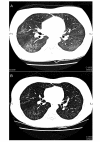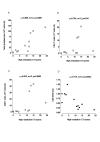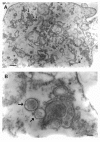Persistence of lung inflammation and lung cytokines with high-resolution CT abnormalities during recovery from SARS
- PMID: 15888207
- PMCID: PMC1156954
- DOI: 10.1186/1465-9921-6-42
Persistence of lung inflammation and lung cytokines with high-resolution CT abnormalities during recovery from SARS
Abstract
Background: During the acute phase of severe acute respiratory syndrome (SARS), mononuclear cells infiltration, alveolar cell desquamation and hyaline membrane formation have been described, together with dysregulation of plasma cytokine levels. Persistent high-resolution computed tomography (HRCT) abnormalities occur in SARS patients up to 40 days after recovery.
Methods: To determine further the time course of recovery of lung inflammation, we investigated the HRCT and inflammatory profiles, and coronavirus persistence in bronchoalveolar lavage fluid (BALF) of 12 patients at recovery at 60 and 90 days.
Results: At 60 days, compared to normal controls, SARS patients had increased cellularity of BALF with increased alveolar macrophages (AM) and CD8 cells. HRCT scores were increased and correlated with T-cell numbers and their subpopulations, and inversely with CD4/CD8 ratio. TNF-alpha, IL-6, IL-8, RANTES and MCP-1 levels were increased. Viral particles in AM were detected by electron microscopy in 7 of 12 SARS patients with high HRCT score. On day 90, HRCT scores improved significantly in 10 of 12 patients, with normalization of BALF cell counts in 6 of 12 patients with repeat bronchoscopy. Pulse steroid therapy and prolonged fever were two independent factors associated with delayed resolution of pneumonitis, in this non-randomized, retrospective analysis.
Conclusion: Resolution of pneumonitis is delayed in some patients during SARS recovery and may be associated with delayed clearance of coronavirus, Complete resolution may occur by 90 days or later.
Figures



Similar articles
-
[Clinical pathology and pathogenesis of severe acute respiratory syndrome].Zhonghua Shi Yan He Lin Chuang Bing Du Xue Za Zhi. 2003 Sep;17(3):217-21. Zhonghua Shi Yan He Lin Chuang Bing Du Xue Za Zhi. 2003. PMID: 15340561 Chinese.
-
High-resolution computed tomography is useful for early diagnosis of severe acute respiratory syndrome-associated coronavirus pneumonia in patients with normal chest radiographs.J Comput Assist Tomogr. 2004 Jan-Feb;28(1):1-9. doi: 10.1097/00004728-200401000-00001. J Comput Assist Tomogr. 2004. PMID: 14716225
-
Clinical manifestations and inflammatory cytokine responses in patients with severe acute respiratory syndrome.J Formos Med Assoc. 2005 Oct;104(10):715-23. J Formos Med Assoc. 2005. PMID: 16385373
-
[Deep lung--cellular reaction to HIV].Rev Port Pneumol. 2007 Mar-Apr;13(2):175-212. Rev Port Pneumol. 2007. PMID: 17492233 Review. Portuguese.
-
Lung inflammatory response in pneumonia.Monaldi Arch Chest Dis. 1998 Feb;53(1):56-63. Monaldi Arch Chest Dis. 1998. PMID: 9632909 Review.
Cited by
-
Recent advances in ZBP1-derived PANoptosis against viral infections.Front Immunol. 2023 May 16;14:1148727. doi: 10.3389/fimmu.2023.1148727. eCollection 2023. Front Immunol. 2023. PMID: 37261341 Free PMC article. Review.
-
Targeting the Complement-Sphingolipid System in COVID-19 and Gaucher Diseases: Evidence for a New Treatment Strategy.Int J Mol Sci. 2022 Nov 18;23(22):14340. doi: 10.3390/ijms232214340. Int J Mol Sci. 2022. PMID: 36430817 Free PMC article. Review.
-
Correlation of Moraxella catarrhalis macrolide susceptibility with the ability to adhere and invade human respiratory epithelial cells.Emerg Microbes Infect. 2022 Dec;11(1):2055-2068. doi: 10.1080/22221751.2022.2108341. Emerg Microbes Infect. 2022. PMID: 35904140 Free PMC article.
-
Pulmonary function test and computed tomography features during follow-up after SARS, MERS and COVID-19: a systematic review and meta-analysis.ERJ Open Res. 2022 May 30;8(2):00056-2022. doi: 10.1183/23120541.00056-2022. eCollection 2022 Apr. ERJ Open Res. 2022. PMID: 35642193 Free PMC article. Review.
-
Immune Profiling of COVID-19 in Correlation with SARS and MERS.Viruses. 2022 Jan 17;14(1):164. doi: 10.3390/v14010164. Viruses. 2022. PMID: 35062368 Free PMC article. Review.
References
-
- Cumulative number of reported probable cases of severe acute respiratory syndrome (SARS) Geneva: World Health Organization. 2003. http://www.who.int/csr/sars/country/en/ Accessed September 26, 2003.
-
- Ksiazek TG, Erdman D, Goldsmith CS, Zaki SR, Peret T, Emery S, Tong S, Urbani C, Comer JA, Lim W, Rollin PE, Dowell SF, Ling AE, Humphrey CD, Shieh WJ, Guarner J, Paddock CD, Rota P, Fields B, DeRisi J, Yang JY, Cox N, Hughes JM, LeDuc JW, Bellini WJ, Anderson LJ, SARS Working Group A Novel coronavirus associated with severe acute respiratory syndrome. N Engl J Med. 2003;348:1953–1966. doi: 10.1056/NEJMoa030781. - DOI - PubMed
-
- Poutanen SM, Low DE, Henry B, Finkelstein S, Rose D, Green K, Tellier R, Draker R, Adachi D, Ayers M, Chan AK, Skowronski DM, Salit I, Simor AE, Slutsky AS, Doyle PW, Krajden M, Petric M, Brunham RC, McGeer AJ, National Microbiology Laboratory, Canada; Canadian Severe Acute Respiratory Syndrome Study Team Identification of severe acute respiratory syndrome in Canada. N Engl J Med. 2003;348:1993–2003. doi: 10.1056/NEJMoa030634. - DOI - PubMed
Publication types
MeSH terms
Substances
LinkOut - more resources
Full Text Sources
Other Literature Sources
Medical
Research Materials
Miscellaneous

